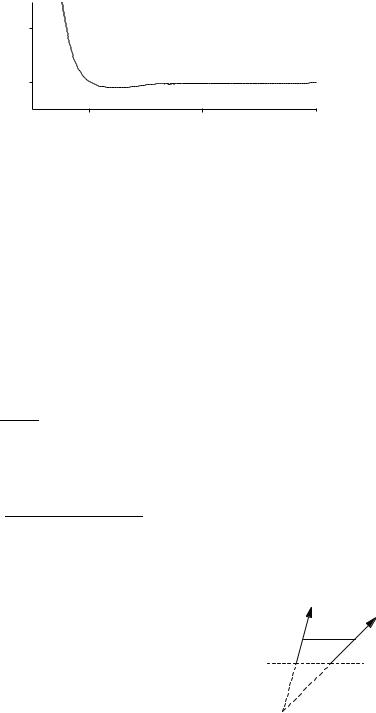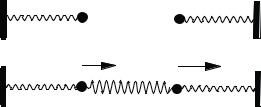
Rogers Computational Chemistry Using the PC
.pdf
124 |
COMPUTATIONAL CHEMISTRY USING THE PC |
|
Energy |
r
Figure 4-15 A van der Waals Potential Energy Function. The Energy minimum is shallow and the interatomic repulsion energy is steep near the van der Waals radius.
where A, B, and C are adjustable parameters. These equations are often used in their modified forms, for example by replacing r0 in Eq. (4-23) by fitting parameters, so as to achieve more flexibility in fitting experimental data (Fig. 4-15).
Coulombic Terms. Coulombic energy of interaction arises from permanent dipoles within the molecule to be modeled, for example, the partial þ and charges within a carbonyl group
d þ d
C¼O
Coulombic potential energy is calculated by modification and fitting of some form of Coulomb’s equation
V ¼ |
qiqj |
ð4-25Þ |
4pe0 rij |
where 4pe0 is the vacuum permittivity (Atkins, 1994). In MM3, the energy of Coulombic interaction of dipoles is calculated by
V |
m ¼ |
mm0ðcos w 3 cos a cos bÞ |
ð |
4-26 |
Þ |
|
D r3 |
||||||
|
|
where m and m0 are the dipole moments of interacting dipoles and D, the dipole moment, is given a default value of 1.5 (seen in the output file) (Fig. 4-16).
µ |
µ ′ |
r
α β
Figure 4-16 Orientation of Dipole Moment Vectors |
χ |
to give Vm.

MOLECULAR MECHANICS: BASIC THEORY |
125 |
|
hydrogen |
|
|
bond |
|
|
H |
.electronegative |
|
θ |
atom |
|
|
|
|
molecule |
|
Figure 4-17 Hydrogen Bonding. |
The angles a, b, and w relate to the orientation of the dipole moment vectors. The geometry of interaction between two bonds is given in Fig. 4-16, where r is the distance between the centers of the bonds. It is noteworthy that only the bond moments need be read in for the calculation because all geometric features (angles, etc.) can be calculated from the atomic coordinates. A default value of 1.0 for dielectric constant of the medium would normally be expected for calculating structures of isolated molecules in a vacuum, but the actual default value has been increased 1.5 to account for some intramolecular dipole moment interaction. A dielectric constant other than the default value can be entered for calculations in which the presence of solvent molecules is assumed, but it is not a simple matter to know what the effective dipole moment of the solvent molecules actually is in the immediate vicinity of the solute molecule. It is probably wrong to assume that the effective dipole moment is the same as it is in the bulk pure solvent. The molecular dipole moment (File 4-3) is the vector sum of the individual dipole moments within the molecule.
The energy of intramolecular hydrogen bonding, if present, is calculated from a modified Buckingham potential [Eq. (4-25)] multiplied by a factor cos y ðL=L0Þ to take into account the angle y between the actual hydrogen bond in the molecule and the ideal hydrogen bond angle (0 ), along with the equilibrium length L of the covalent bond of hydrogen as compared to its normal bond length L0 (Fig. 4-17).
In the case of ions, energies of charge-charge interaction are calculated directly from the Coulomb equation and charge-dipole interaction energies are calculated from a Coulomb equation with a geometric modification to account for the angle between the dipole moment and the charge (Tripos, 1992).
COMPUTER PROJECT 4-3 The Butane Conformational Mix
We know from the discussion above that n-butane has an anti and two gauche forms (mirror images). These are called stable conformers. Molecules having a dihedral angle o (see Fig. 4-18) that is not at a minimum of energy are unstable configurations. Although all three conformers, anti and two gauche forms, are stable in the energetic sense that they are at the minima of potential energy wells, there is enough thermal energy kBT that can be absorbed from the environment at any normal temperature T 6¼0 to drive any conformer up over the potential maximum in Fig. 4-18 and change (twist) it into any other conformer. Interconversion is

126 |
COMPUTATIONAL CHEMISTRY USING THE PC |
Figure 4-18 The Potential Energy for |
V |
Rotation of n-Butane About its Central |
|
Bond Axis. The anti conformer in the |
|
center is slightly lower in energy than |
ω |
the two gauche conformers. |
very rapid, and no conformer can be obtained in the absence of the others. The system exists as an equilibrium conformational mix.
We have it on good authority (Ege, 1998) that the gauche minimum on the potential energy coordinate is about 0.9 kcal mol 1 higher in energy than the anti conformation. This establishes a two-state energy system for the stable conformers, gauche and anti (Fig. 4-19).
We know from the section on molecular speads in Chapter 1 and Computer Project 3-2 that particles distribute themselves over an energy level spectrum in a very definite way, governed by the Boltzmann equation, Eq. (3-39), N ¼ N0eðmgh=kBTÞ in the gravitational field. Equation (3-39) can be slightly modified by noting that mgh is the potential energy of an object of mass m in the potential field. If we use V to designate the potential energy not of gravity, but of twisting about the dihedral angle in n-butane, and if we use N to denote the number of n-butane molecules in the gauche condition relative to N0 molecules as the anti conformer,
N |
¼ 2e ðV=kBTÞ |
ð4-27Þ |
N0 |
where we have arbitrarily set the potential energy of the anti conformer to 0 and we have included the number 2 to account for the two-fold degeneracy of the upper (gauche) energy level. (Each of the degenerate gauche levels can be considered to accommodate its own population of molecules, independent of the other.) Strictly speaking, the ratio N=N0 is a ratio of probabilities, but we shall take 1 mole as the number of molecules so a calculated ratio of probabilities is a virtual certainty. There is, of course, no restriction that the number of conformers must be two; the method can be extended to many conformers as we would expect to do for more complicated molecules. The object of this computer project is to find precise values of V, the separation between or among conformers, and to use V to calculate the relative populations of the conformers in the equilibrium conformational mix.
} ~ 0.9 kcal mol –1
Figure 4-19 Two-Level Energy Spectrum. The upper level is two-fold degenerate.

MOLECULAR MECHANICS: BASIC THEORY |
127 |
Procedure. Use the PCMODEL GUI to draw the anti carbon skeleton
and left click H/AD to attach hydrogen atoms. The approximate input model appears. Left click on force field, select MM3 and left click on compute ! minimize. The final (optimized) model appears with the MM3 energy (the steric energy).
Do the same thing with the unstable configuration resulting from the carbon skeleton
It will relax to one of the gauche conformers. Use the difference in steric energies to calculate the equilibrium populations of the ground state and the two upper gauche conformations at 298.15 K. Calculate and report the relative populations at 200 and 500 K. Repeat the entire project using the MMFF94 force field of Halgren and Nachbar (Halgren and Nachbar, 1996) to be found using the force field option.
A Conformational Search-Global MM
Both PCMODEL (Serena Software) and MM3 (Tripos) have search routines that permit the user to enter one conformer of a molecule and find all others. (Strictly, no conformational search routine guarantees that all conformers have been found, but in simple cases the chances are pretty good.) There are several strategies for conformational searching, but a good one is to optimize the geometry for a plausible input structure, randomly change the input geometry, optimize again, and keep on doing this until one has reasonable assurance that all conformers have been found. Random changes in the input geometry are often called ‘‘kicks.’’ This simplistic strategy is what anyone might think of, except that the computer implementation is a lot faster than you are. In taking many starting points, each with a different geometry and potential energy, one is said to have searched the potential surface for a specific mode of motion of the molecule. More than one mode of motion can be searched at the same time.
To conclude this computer project, we shall first search the potential surface for rotation of n-butane about its 2,3 C C bond, for which we think we know the answer, then search the potential surface for 1-butene, for which we do not. In 1-butene, the double bond establishes a rigid plane but the methyl group can take up several different positions relative to it by rotation about the 2-3 single bond.
CH3
CH2CH3 |
|
CH2 etc. |
Procedure. Open PCMODEL and work through this procedure step by step. Otherwise, these instructions will be cryptic.

128 |
COMPUTATIONAL CHEMISTRY USING THE PC |
n-Butane: Minimize anti n-butane as in the MM3 procedure above. Go to Compute ! GMMX. Search on bonds. Setup bonds, select all and hit OK. Enter Job Name 1-butene and Run Gmmx. You will see the model being ‘‘kicked’’ repeatedly. Left click outside of the GMMX Run box. You should see 3 # minimized and 3 # found. We already know that there are only three conformers, two of which are degenerate; hence, because Ecurrent 6¼Eminimum we know all the energies there are. Subtracting the lower from the higher energy permits calculation of the population ratios of the conformational mix. If your energy difference is not the same as the one you got in the first part of this project, check to see that you are using the MM3 force field.
1-Butene: Now we shall look for the energies of the conformational mix of 1-butene. We know less about this molecule than we did about n-butane, so the procedure will be a little more complicated.
Minimize the cis rotamer in the MM3 force field starting from the skeleton
using Add_B to make your double bond. Go to compute ! GMMX. Enter Job Name 1-butene and setup bonds, select all (you are searching only rotations about the 2,3 bond) and hit OK. Run Gmmx. Left click outside of the GMMX Run box. You should see 3 # minimized and 3 # found, but this time we do not know how many conformers there are. Stop Job and go to File ! open 1-butene. You should see a structure list. Only three conformers are given, two of which are, again, degenerate. In fact, there are four conformers, but two have energies so high that they do not contribute significantly to the conformational mix. (Fig. 4-20). Calculate the population ratios at 200, 298.15, and 500 K in the MM3 and MMFF94 force fields for 1-butene just as you did for n-butane.
Figure 4-20 Rotamers (rotational conformers) of 1-Butene (Nevins, Chen, and Allinger, 1996).
cis gauche skew trans
Cross Terms
A simple example of a cross term is the stretch-bend interaction. If the angle ABC, having elastic AB and BC bonds, is closed, the bonds stretch because of repulsion between atoms A and C. The opposite is true if the angle is opened. Thus the stretch and bend of the system ABC are not independent; rather, they are coupled. The stretch-bend coupling term might take the bilinear form
Vstretch bend ¼ kSBðr r0Þðy y0Þ |
ð4-28Þ |

MOLECULAR MECHANICS: BASIC THEORY |
129 |
where r is the bond length and y is the simple angle. There are many possible cross terms
Vstretch stretch ¼ kSSðr r0Þðr0 r00 Þ |
|
Vbend bend ¼ kBBðy y0Þðy0 y00 Þ |
ð4-29Þ |
Vstretch torsion ¼ kSTðr r0Þ cos no
and others. It soon becomes evident that there are many terms that can be included in the energy equation, Eq. (4-13), and the question is how many to accept and how many to reject. Fewer terms are used in the energy equation for large molecules like proteins that tax computer resources. Many terms are used when one wants an accurate and detailed model of relatively small molecules or to calculate spectra, which demand a knowledge of not only the location of a potential well but also its depth and shape as well.
PROBLEMS
1.A 1.00-g mass connected to a fixed point by a spring oscillates at a frequency of 10.0 Hz. What is the Hooke’s law force constant of the spring? Give units.
2.A slender vertical filament of negligible mass supports a 0.200-g mass at one end and is fixed at the other end. A force of 0.0800 N displaces the mass 0.0200 m. The mass executes simple harmonic motion as the filament bends. What is the bending constant KB of the filament? What is the frequency n of the motion in Hz? What is the period t of oscillation?
3.The balance wheel of a chronometer is constructed so that its entire mass of 0.100 g may be considered to be concentrated in a ring of radius 0.600 cm. What is its moment of inertia?
4.The balance wheel in Problem 3 is driven by a coiled spring called a hairspring. The wheel executes simple harmonic angular motion between the two angular limits shown by the double arrow in Problem 3. Its oscillation over the marked excursion is complete every 0.500 s. What is the torsion constant k of the spring?
5.Write the rotational analog of Hooke’s law for the torque t driving the oscillation in Problem 3. Write the rotational analog of Newton’s second law. Combine the two laws to obtain the rotational analog of the Newton– Hooke equation, Eq. (4-1).
6.Calculate the reduced mass of D35Cl where D is the deuterium isotope of hydrogen (isotopic weight 2.014 atomic mass units) and 35Cl is the 35 isotope of chlorine (isotopic weight 34.97 atomic mass units).
130 |
COMPUTATIONAL CHEMISTRY USING THE PC |
7. |
Gaseous H35Cl has a strong absorption band centered at about l ¼ |
|
3:40 10 6 m in the infrared portion of the electromagnetic radiation spec- |
trum. On the assumption that D bonds to Cl with the same strength that H does, predict the frequency of vibration in Hz and rad 1 of D35Cl.
8.Under what circumstances would the maximum speed be numerically equal to the maximum excursion for a simple harmonic oscillator?
9.Given the O H bond distance calculated from the MM3 parameter set for the
˚ water molecule as 0.947 A 94.7 pm and the H O H bond angle of 105 ,
what is the distance between the H nuclei in H2O in the gas phase?
10.Given the bond distances and internuclear angle in Problem 9, what is the moment of inertia of the H2O molecule about its principal axis through the oxygen atom (the y-axis in File 4-5)?
11.Calculate the moment of inertia about the x-axis of ethylene.
12.Convert the three moments of inertia in File 4-3 to MKS units.
13.What is the moment of inertia of acetylene about its C C axis?
14.Using TINKER and the MM3 force field, determine the S H bond length and the H S H bond angle in H2S. Compare these values with what you found for the H2O molecule. Compare them with the values you find in a general chemistry textbook. Using PCMODEL, with the MMFF94 force field, determine the S H bond length and the H S H bond angle in H2S. Compare these values with what you found for the H2O molecule. Compare them with the values you find in a general chemistry textbook.

C H A P T E R
5
Molecular Mechanics II:
Applications
The three main goals of a molecular mechanics program for small molecules are calculation of geometry, energy, and spectral absorbances due to vibrational excitation. Hagler (Hwang, Stockfish, and Hagler, 1994) has categorized force fields into class 1, intended to achieve the first of these increasingly demanding objectives; class 2, to achieve the first two; and class 3 to achieve all three objectives. Research and development on class 3 force fields is an active enterprise, as is extension of class 1 and class 2 force fields to less common molecules and larger, biologically important species. We have already introduced geometry determination in Chapter 4.
Coupling
We shall treat coupling of modes of motion in some detail because there are fundamental mechanical and mathematical topics involved that will be useful to us in both MM and quantum mechanical calculations. In the treatment of coupled harmonic oscillators, matrix diagonalization and normal coordinates are encountered in a simple form.
Computational Chemistry Using the PC, Third Edition, by Donald W. Rogers ISBN 0-471-42800-0 Copyright # 2003 John Wiley & Sons, Inc.
131

132 |
COMPUTATIONAL CHEMISTRY USING THE PC |
a
x1 |
x2 |
b
Figure 5-1 (a) Uncoupled and (b) Coupled Harmonic Oscillators.
Two harmonic oscillators consisting of identical masses driven by identical springs have identical frequencies of oscillation (Fig. 5-1a). If they are connected by a third spring as in Fig 5-1b, their motions are no longer independent. The tension on the spring accelerating one mass depends on the location of the other mass on the x-axis. The motions of m1 and m2 are said to be coupled. The excursions x1 and x2 in Fig. 5-1 represent displacements from an equilibrium configuration on the x-axis.
Suppose, for simplicity, that the masses in Fig. 5-1b are the same, m1 ¼ m2 ¼ m, and all three springs are the same, but velocities and displacements of the masses may not be the same. Let one mass be displaced by a distance x1 from its equilibrium position while the other is displaced by a distance x2. The only place the potential energy V
ð |
ð |
|
V ¼ F dx ¼ kxi dxi ¼ 21 kxi2 |
ð5-1Þ |
|
can be stored is in the springs. V is the sum of the potential energies of the three springs, two lateral and one coupling spring
V ¼ 21 kx12 þ 21 kðx1 x2Þ2 þ 21 kx22 |
ð5-2Þ |
By hypothesis, the force constant of the coupling spring is the same as k for the other two springs, so the potential energy can be written
V ¼ 21 kx12 þ 21 kðx12 2x1x2 þ x22Þ þ 21 kx22 |
|
¼ kx12 kx1x2 þ kx22 |
ð5-3Þ |
Note especially the center term in Eq. (5-3). Physical coupling of the masses leads to a term dependent on both x1 and x2. Equation (5-3) as written is not separable into an equation only in x1 and an equation only in x2.

MOLECULAR MECHANICS II: APPLICATIONS |
133 |
From Newton’s second law, noting that more than one force may influence each
P1 |
|
|
1 |
|
|
i |
|
d2x |
|
mass, f |
¼ ma where a is the acceleration a ¼ dvdt |
¼ |
dt2 |
. For the coupled masses |
|||||
m€x |
¼ |
ma |
|
¼ Xi |
f |
|
5-4 |
||
|
|
|
|
|
|
|
|||
m€x2 ¼ ma2 ¼ Xj |
fj |
ð Þ |
|||||||
We have used a common notation from mechanics in Eq. (5-4) by denoting velocity, the first time derivative of x, x, and acceleration, the second time derivative, €x. In a conservative system (one having no frictional loss), potential energy is dependent only on the location and the force on a particle qqVx ¼ fx; hence, by differentiating Eq. (5-3),
X
fi ¼ 2kx1 þ kx2
i
X
fj ¼ 2kx2 þ kx1
j
which leads to
m€x1 ¼ 2kx1 þ kx2 m€x2 ¼ 2kx2 þ kx1
and |
|
|
|
|
||
€x1 þ 2 |
k |
|
k |
¼ 0 |
||
|
x1 |
|
x2 |
|||
m |
m |
|||||
|
k |
|
k |
ð5-7Þ |
||
€x2 þ 2 |
|
x2 |
|
|
x1 |
¼ 0 |
m |
m |
|||||
Let us take a pair of trial solutions on the reasonable guess that, however the coupling spring influences the motion, the masses will oscillate harmonically.
x1 ¼ A1 cos o t x2 ¼ A2 cos o t
with an unknown angular frequency o. Because the masses and the springs are the same, the system is symmetrical and we do not need to worry about different frequencies for m1 and m2. This leads to
d
x1 ¼ dt A1 cos o t ¼ A1o sin o t
d
x2 ¼ dt A2 cos o t ¼ A2o sin o t
€x1 ¼ d A1o sin o t ¼ A1o2 cos o t dt
€x2 ¼ d A2o sin o t ¼ A2o2 cos o t dt
